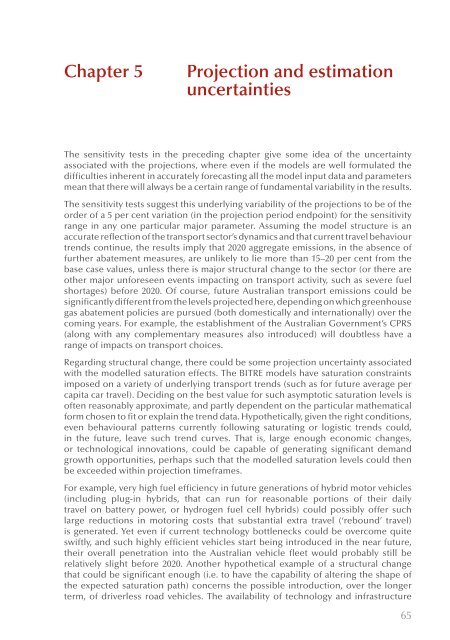PDF: 9795 KB - Bureau of Infrastructure, Transport and Regional ...
PDF: 9795 KB - Bureau of Infrastructure, Transport and Regional ...
PDF: 9795 KB - Bureau of Infrastructure, Transport and Regional ...
You also want an ePaper? Increase the reach of your titles
YUMPU automatically turns print PDFs into web optimized ePapers that Google loves.
Chapter 5<br />
Projection <strong>and</strong> estimation<br />
uncertainties<br />
The sensitivity tests in the preceding chapter give some idea <strong>of</strong> the uncertainty<br />
associated with the projections, where even if the models are well formulated the<br />
difficulties inherent in accurately forecasting all the model input data <strong>and</strong> parameters<br />
mean that there will always be a certain range <strong>of</strong> fundamental variability in the results.<br />
The sensitivity tests suggest this underlying variability <strong>of</strong> the projections to be <strong>of</strong> the<br />
order <strong>of</strong> a 5 per cent variation (in the projection period endpoint) for the sensitivity<br />
range in any one particular major parameter. Assuming the model structure is an<br />
accurate reflection <strong>of</strong> the transport sector’s dynamics <strong>and</strong> that current travel behaviour<br />
trends continue, the results imply that 2020 aggregate emissions, in the absence <strong>of</strong><br />
further abatement measures, are unlikely to lie more than 15–20 per cent from the<br />
base case values, unless there is major structural change to the sector (or there are<br />
other major unforeseen events impacting on transport activity, such as severe fuel<br />
shortages) before 2020. Of course, future Australian transport emissions could be<br />
significantly different from the levels projected here, depending on which greenhouse<br />
gas abatement policies are pursued (both domestically <strong>and</strong> internationally) over the<br />
coming years. For example, the establishment <strong>of</strong> the Australian Government’s CPRS<br />
(along with any complementary measures also introduced) will doubtless have a<br />
range <strong>of</strong> impacts on transport choices.<br />
Regarding structural change, there could be some projection uncertainty associated<br />
with the modelled saturation effects. The BITRE models have saturation constraints<br />
imposed on a variety <strong>of</strong> underlying transport trends (such as for future average per<br />
capita car travel). Deciding on the best value for such asymptotic saturation levels is<br />
<strong>of</strong>ten reasonably approximate, <strong>and</strong> partly dependent on the particular mathematical<br />
form chosen to fit or explain the trend data. Hypothetically, given the right conditions,<br />
even behavioural patterns currently following saturating or logistic trends could,<br />
in the future, leave such trend curves. That is, large enough economic changes,<br />
or technological innovations, could be capable <strong>of</strong> generating significant dem<strong>and</strong><br />
growth opportunities, perhaps such that the modelled saturation levels could then<br />
be exceeded within projection timeframes.<br />
For example, very high fuel efficiency in future generations <strong>of</strong> hybrid motor vehicles<br />
(including plug-in hybrids, that can run for reasonable portions <strong>of</strong> their daily<br />
travel on battery power, or hydrogen fuel cell hybrids) could possibly <strong>of</strong>fer such<br />
large reductions in motoring costs that substantial extra travel (‘rebound’ travel)<br />
is generated. Yet even if current technology bottlenecks could be overcome quite<br />
swiftly, <strong>and</strong> such highly efficient vehicles start being introduced in the near future,<br />
their overall penetration into the Australian vehicle fleet would probably still be<br />
relatively slight before 2020. Another hypothetical example <strong>of</strong> a structural change<br />
that could be significant enough (i.e. to have the capability <strong>of</strong> altering the shape <strong>of</strong><br />
the expected saturation path) concerns the possible introduction, over the longer<br />
term, <strong>of</strong> driverless road vehicles. The availability <strong>of</strong> technology <strong>and</strong> infrastructure<br />
65

















